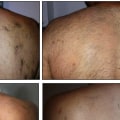Laser hair removal is a safe and effective way to get rid of unwanted hair. But for people with dark skin, the procedure can be more complicated. Darker skin tones can be more sensitive to laser treatments, and therefore, it is important to be aware of the risks and side effects that can come with laser hair removal. In this article, we will discuss the proper techniques to reduce risks and side effects of laser hair removal for dark skin, so that you can make an informed decision about whether this procedure is right for you. The first step in reducing risks and side effects for laser hair removal for dark skin is to choose the right laser device and settings.
It is important to use a device with a long-pulsed laser that has a large spot size, which will penetrate deeper into the skin and provide better coverage. The wavelength and power settings should also be adjusted according to the patient’s skin type. It is also important to properly prepare for the procedure. Patients should avoid sun exposure and use a topical anesthetic cream if needed.
Additionally, a cooling gel should be applied to the area before treatment to help protect the skin from the laser's heat. Finally, post-procedure care is essential to reduce any potential side effects or risks. Patients should avoid sun exposure, use sunscreen, and apply a moisturizer regularly. Additionally, they should avoid picking at or scratching the treated area. Keeping the area clean and following post-procedure instructions from the physician are also essential for reducing risks and side effects. When it comes to laser hair removal for dark skin, the proper technique is key to reducing risks and side effects.
Choosing the right laser device and settings, preparing for the procedure, and following post-procedure care are all important steps in minimizing risks and keeping side effects to a minimum.
Post-Procedure Care
After laser hair removal, it is important for patients with dark skin to take certain precautions in order to reduce potential risks and side effects. Patients should avoid sun exposure as much as possible by using sunscreen and wearing protective clothing when outdoors. Additionally, it is important to apply a moisturizer regularly to keep the skin well hydrated. Finally, patients should avoid picking at or scratching the treated area, as this can increase the risk of skin discoloration or scarring. In conclusion, proper post-procedure care is essential for reducing risks and side effects of laser hair removal for dark skin.Patients should avoid sun exposure, use sunscreen, apply a moisturizer regularly, and avoid picking at or scratching the treated area in order to ensure a safe and successful treatment.
Preparing for the Procedure
Before getting laser hair removal treatment, it is important to properly prepare for the procedure in order to reduce risks and side effects. Patients should avoid sun exposure and use a topical anesthetic cream prior to the procedure. Additionally, a cooling gel should be applied before treatment to further minimize any potential risks or side effects. Sun exposure should be avoided for at least two weeks before the procedure. This is because direct sunlight can make the skin more sensitive to the laser light and increase the risk of burns or other skin injuries.For patients with dark skin, especially those of African descent, it is even more important to avoid sun exposure before getting laser hair removal. It is also recommended that patients use a topical anesthetic cream before the procedure. This will help to reduce any discomfort caused by the laser beams. Additionally, applying a cooling gel before treatment can help to further reduce any potential risks or side effects. By properly preparing for the procedure, patients can reduce the risks and side effects associated with laser hair removal for dark skin. Avoiding sun exposure, using a topical anesthetic cream, and applying a cooling gel before treatment are all important steps for ensuring a safe and successful procedure.
Choosing the Right Laser Device and Settings
When it comes to laser hair removal on dark skin, choosing the right laser device and settings is essential.Different laser devices have different wavelengths and fluences, so it's important to select one that is suitable for the patient's skin type. Additionally, the settings used during the procedure must be adjusted according to the patient's skin type to minimize any potential risks or side effects. A common mistake is using a laser device with a wavelength that is too long for dark skin. This can cause increased risks of hyper- or hypopigmentation, which is an undesired lightening or darkening of the skin. To avoid this, it is important to choose a laser device with a wavelength between 755-800 nm. The fluence, or energy output of the laser device, is also important to consider.
Lower fluences are generally recommended for darker skin types because higher fluences may cause more side effects. Generally, a fluence of 8-10 joules/cm2 is recommended for dark skin. It is also important to adjust the settings used during the procedure according to the patient's skin type. For dark skin, shorter pulse durations and lower spot sizes are typically recommended in order to minimize any potential risks or side effects. In summary, it is essential to choose the right laser device and settings when performing laser hair removal on dark skin. The wavelength should be between 755-800 nm, and the fluence should be around 8-10 joules/cm2. Additionally, the settings used during the procedure should be adjusted according to the patient's skin type. In conclusion, reducing risks and side effects of laser hair removal for dark skin requires careful consideration.
Choosing the right laser device and settings, properly preparing for the procedure, and following post-procedure care instructions are all essential for achieving safe and successful results. By understanding the different types of lasers available, taking the necessary precautions before and after the procedure, and visiting a qualified dermatologist, you can ensure that you receive the best treatment possible with minimal risk.







